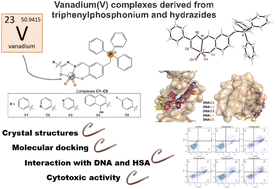Vanadium(v) complexes derived from triphenylphosphonium and hydrazides: cytotoxicity evaluation and interaction with biomolecules†
Abstract
The development of coordination compounds with antineoplastic therapeutic properties is currently focused on non-covalent interactions with deoxyribonucleic acid (DNA). Additionally, the interaction profiles of these compounds with globular plasma proteins, particularly serum albumin, warrant thorough evaluation. In this study, we report on the interactions between biomolecules and complexes featuring hydrazone-type imine ligands coordinated with vanadium. The potential to enhance the therapeutic efficiency of these compounds through mitochondrial targeting is explored. This targeting is facilitated by the derivatization of ligands with triphenylphosphonium groups. Thus, this work presents the synthesis, characterization, interactions, and cytotoxicity of dioxidovanadium(V) complexes (C1–C5) with a triphenylphosphonium moiety. These VV-species are coordinated to hydrazone-type iminic ligands derived from (3-formyl-4-hydroxybenzyl)triphenylphosphonium chloride ([AH]Cl) and aromatic hydrazides ([H2L1]Cl–[H2L5]Cl). The structures of the five complexes were elucidated through single-crystal X-ray diffraction and vibrational spectroscopies, confirming the presence of dioxidovanadium(V) species in various geometries with degrees of distortion (τ = 0.03–0.50) and highlighting their zwitterionic characteristics. The molecular structural stability of C1–C5 in solution was ascertained using 1H, 19F, 31P, and 51V-nuclear magnetic resonance. Moreover, their interactions with biomolecules were evaluated using diverse spectroscopic methodologies and molecular docking, indicating moderate interactions (Kb ≈ 104 M−1) with calf thymus DNA in the minor groove and with human serum albumin, predominantly in the superficial IB subdomain. Lastly, the cytotoxic potentials of these complexes were assessed in keratinocytes of the HaCaT lineage, revealing that C1–C5 induce a reduction in metabolic activity and cell viability through apoptotic pathways.



 Please wait while we load your content...
Please wait while we load your content...